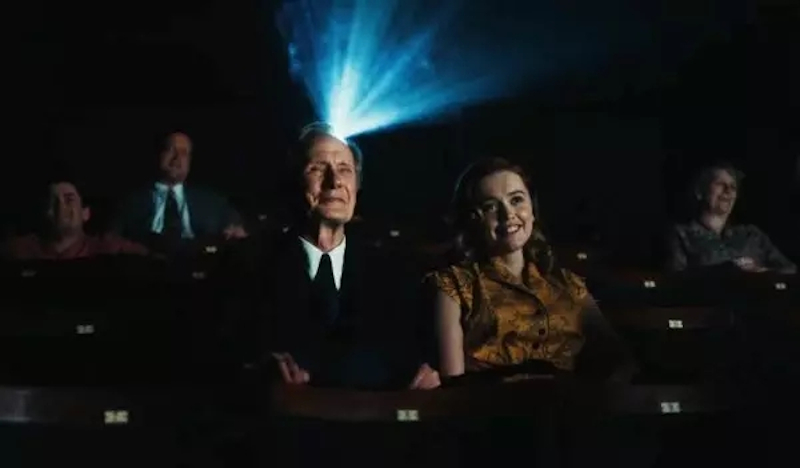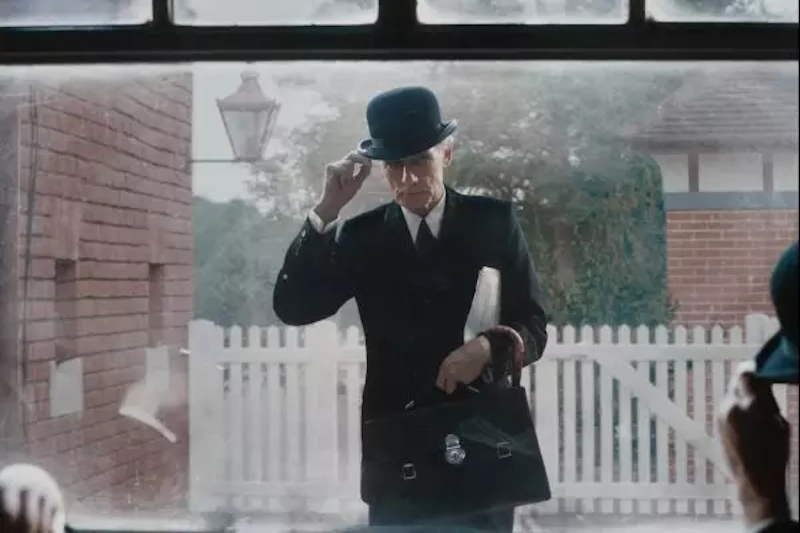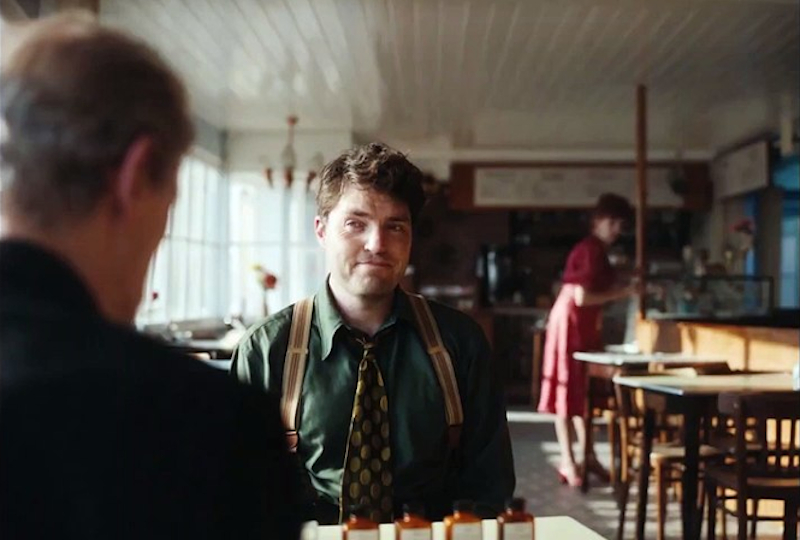Director – Oliver Hermanus – 2022 – UK – Cert. 12a – 102m
*****
Diagnosed with stomach cancer and given only months to live, a bureaucrat searches for something – anything – to give purpose to his hitherto meaningless life in this remake of Akira Kurosawa’s Ikiru – out in UK cinemas on Friday, November 4th following its screenings in the BFI London Film Festival 2022, while Ikiru is on BFI Player subscription
For anyone who has had the privilege of seeing Ikiru (Akira Kurosawa, 1952) it is a very strange thing to watch this remake of it. On the one hand, it is exactly the same film. It has the same plot. On the other, it is completely different. Both are set in the 1950s, the original in Japan and the new one in London.
At this point, I have to say that this remake sounded to me (until I’d seen it) like a very bad idea. Cinema is littered with great films that have been remade as shadows of their former selves. Generally speaking, most ideas like this are better left well alone. To make matters worse, this is a case of an established novelist writing a screenplay: producers love this because they see a bestselling author as having a reliable track record but, in fact, the skills required for writing a novel and a movie are very different indeed.

In the case of Kasuo Ishiguro, a couple of his novels have been turned into highly regarded films (Never Let Me Go, Mark Romanek, 2010; The Remains Of The Day, James Ivory, 1993) but in neither case did the author write the screenplay himself. According to the press handouts, the current film grew out of a dinner between the author and producer Stephen Woolley where the pair, both film buffs, were swapping notes on classic movies and Ishiguro mentioned he’d always wanted to see a British re-imagining of Ikiru.
Ishiguro was somewhat horrified by Woolley’s suggestion that he write it, feeling that he lacked the necessary skills. Perhaps the writer’s humility in this regard is the factor that’s delivered a screenplay which hasn’t really changed the essence of the film but has re-imagined its Japanese qualities as British ones. If ever proof were needed that the two cultures have much in common in certain areas, it is to be found here.

A local government bureaucrat is used to giving troublesome residents the runaround. When a group of women petition to turn a piece of waste ground in a deprived area into a children’s playground, they get passed between various departments before the paperwork is filed on his desk where nothing will happen to it. A visit to the doctor reveals the bureaucrat has stomach cancer and months to live. Attempting to reassess his life, he breaks his hitherto impeccable record of turning up at the office; he doesn’t come in. He goes out and paints the town red, with the help of someone he meets who knows how to go about such things as night life is an unfamiliar world to him. But that doesn’t do the trick.
Eventually, he is spotted on the street by a young woman from his team at work, who needs him to give her a reference for a new job as she’s decided the office isn’t really for her, who he takes to dinner, and a friendship ensues. After a time of absence, he comes back into the office determined to champion the women’s proposed playground and give his own life some sort of meaning in the process.

Ishiguro’s reimagining is set in London, and he introduces a very British, railway commuter culture. He adds the character of a young, new recruit Peter (Alex Sharp) who at the start is travelling by train from the suburbs to major London terminus Waterloo for his first day at the office. On the journey Peter meets several of his more experienced colleagues but not his boss Mr. Williams (Bill Nighy) who never travels in the same compartment as those who work with him. This device comes in handy later on, after Williams’ death, when rather than deploying a lengthy funeral scene as a vehicle for flashbacks to explain what happened with the bureaucrat, as Kurosawa’s film did, Ishiguro replaces it with conversations on the daily commute into which the flashbacks fit perfectly.
Thus Peter becomes our means of entry into the story and, initially at least, our point of view for observing Mr. Williams. He eventually falls for the young girl in the office Margaret (Aimee Lou Wood), who has set her sights on leaving to become a manager at the local Lyons Corner House. However the screenplay wisely never allows that romance to become more than a footnote, albeit a captivating one. It’s Mr. Williams’ story, and that character is at the centre of the film.
Barely changing the plot – why would you when the original is so brilliant? – Ishiguro litters the dialogue with wonderful invention or observation. After the petitioning women have been sent around the building in the ‘capable hands’ of Peter (on his first day, so they have to show him around) and the file returns to Mr. Williams’ desk, Williams lodges it in his paperwork pile with the legend, “I’ll put it here – it’ll do no harm.” Which it will, of course, because this ensures no action will be taken.

These piles of paperwork in Williams and others’ in-trays are known as ‘skyscrapers’, a phrase invoking the high-tech, go-getter attitude of New York when the British office version is all about looking busy so that you don’t have to work too hard (the trick is to keep your skyscraper high, Margaret helpfully tells Peter).
Aside from the unbeatable casting of Nighy, which was Ishiguro’s idea from the beginning, the casting by director Hermanus (Moffie, 2019) is spot on. He also opts to shoot the film in the 4:3 Academy ratio (the so-called old TV rectangle shape) and the film looks like it was shot on fifties film stock, which must have taken quite a bit of doing and adds considerably to both the period feel and the overall charm of the piece. A bigger coup still is that for the locations, the production secured County Hall, the former home of London’s local government, and most of the office scenes are shot there.
Nighy delivers one of the best performances of his career – I’d go as far as to say, the only two films of his you need to see are this one and I Capture The Castle, (Tim Fywell, 2003), in which he is equally brilliant – inhabiting the role like he was born to play it. The scene where he paints the town red takes place not in the same city as the office, as in the original, but rather in Brighton, where Williams chances to meet hedonistic playwright Sutherland (Tom Burke, the male lead from The Souvenir, Joanna Hogg, 2019), another perfect piece of casting. Nighy’s scenes with Wood as the young woman employee are another element that proves deeply affecting.

All in all, this is an amazing film that seems to get at the very soul of Britishness. I would imagine that the Japanese, having originated the source material, would take it to their hearts, not least because it reflects certain aspects shared by both cultures (and Ishiguro, although British, is British-Japanese, speaks both languages and was raised (here) within the trappings of Japanese culture (at home). What non-Brits other than the Japanese will make of it is anyone’s guess, but with any luck its Britishness will prove highly exportable. Like the film that inspired it, this is an absolute must-see. If the general rule is that remakes of great films don’t measure up, this is a rare exception.
Living is out in cinemas in the UK on Friday, November 4th following its screening in the BFI London Film Festival 2022. Ikiru is on BFI Player subscription.
Trailer:
Trailer – Ikiru (Criterion):
LFF 2022 Trailer:
